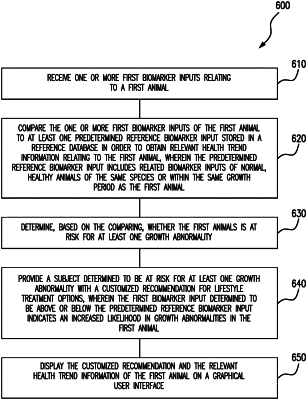| CPC G16H 50/30 (2018.01) [A61B 5/1075 (2013.01); A61B 5/7275 (2013.01); G16H 20/30 (2018.01); G16H 20/60 (2018.01); G16H 50/20 (2018.01); A61B 2503/40 (2013.01)] | 24 Claims |

|
1. A method of diagnosing growth abnormalities in order to maintain optimal growth in non-human animals, by one or more servers, comprising:
receiving, from a user computer, one or more first biomarker inputs and one or more personalized biomarker inputs relating to a first animal, wherein the one or more first biomarker inputs are selected from a group of biomarkers including animal identification or approximate animal size, animal breed, sex, date of birth, age, weight, date of measurement, and a neutering status, wherein the one or more first biomarker inputs comprise at least the neutering status;
comparing the one or more first biomarker inputs of the first animal to at least one predetermined reference biomarker input stored in a reference database in order to obtain relevant health trend information relating to the first animal, wherein the predetermined reference biomarker input includes related biomarker inputs of healthy animals of the same species or within the same growth period as the first animal;
training, based on the reference database, a linear discriminant analysis model configured for predicting body condition scores;
constructing one or more reference growth centile curves and using a first generalized additive model for location, shape, and scale (GAMLSS) based on a box-cox cole-green (BCCG) function and a second GAMLSS based on a box-cox power exponential (BCPE) function;
generating, based on the neutering status, one or more adjusted reference growth centile curves for the one or more reference growth centile curves, respectively;
executing the linear discrimant analysis model to predict a body condition score for the first animal from the one or more first biomarker inputs comprising at least the neutering status;
transforming the relevant health trend information, the one or more adjusted reference growth centile curves, and the body condition score to an output assessment comprising whether the first animal is at risk for at least one growth abnormality;
generating, responsive to determining that the first animal is at risk for at least one growth abnormality, a customized recommendation for lifestyle treatment options, wherein the first biomarker input determined to be above or below the predetermined reference biomarker input indicates an increased likelihood in growth abnormalities in the first animal, and wherein the lifestyle treatment options are selected from a plurality of lifestyle treatment options in part based on their respective effectiveness with respect to the first animal; and
sending, to the user computer, instructions for presenting the customized recommendation, the one or more adjusted reference growth centile curves, and the relevant health trend information of the first animal.
|